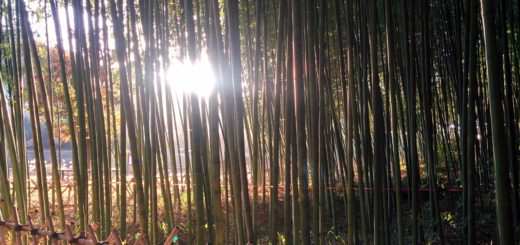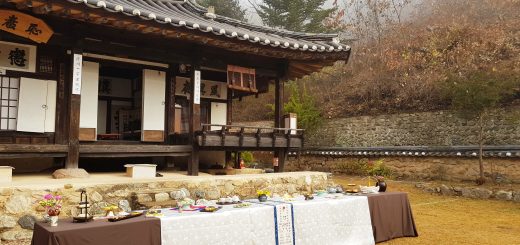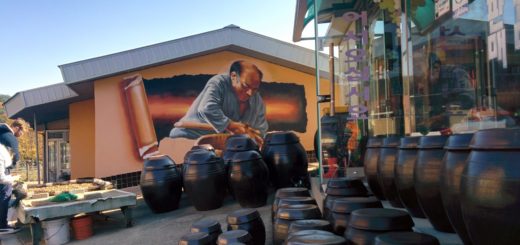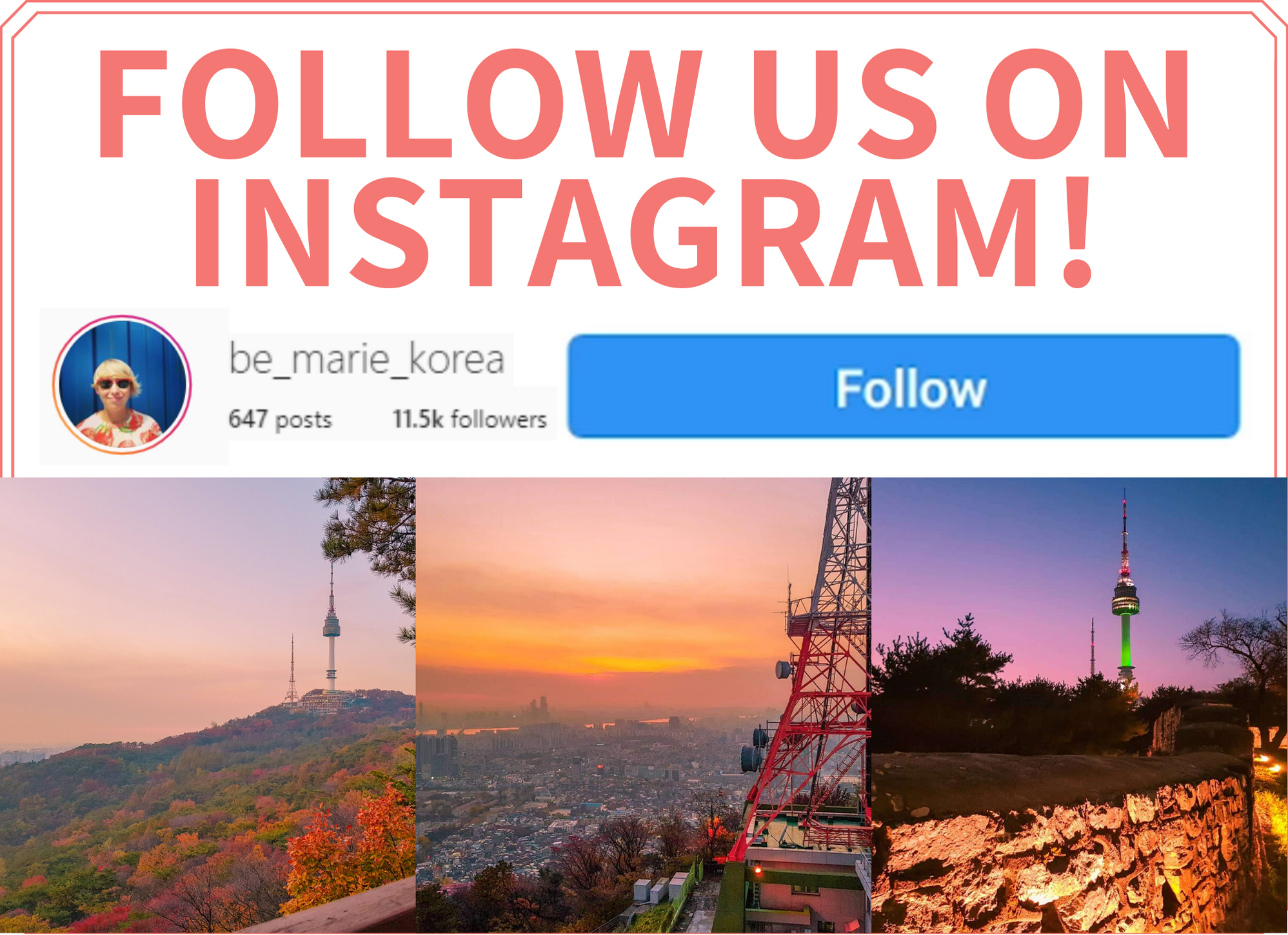The Gwangyang International Maehwa Festival
The beautiful Gwangyang Maehwa Village is nestled close to the Seomjingang River in Jeollanam-do, and is particularly famed for its stunning plum blossom trees. The blossoms typically start to appear in early March, and reach their full bloom by the middle of the month creating a snowy tableau of breathtaking beauty.
Each year, the region hosts the Gwangyang International Maehwa Festival, which attracts hordes of tourists from all over the country, captivated by the natural allure of the region. Visitors have the opportunity to meander around the picturesque village, taking in the breathtaking petal-laden trees and the tranquil atmosphere they imbue.
While plum flowers can exhibit a range of colours depending on their specific variety, most of the blossoms found in Maehwa village are pure white, which lends the whole area an ethereal and tranquil atmosphere. The village, therefore, resembles a snow-covered wonderland, transporting visitors into a realm of serenity amidst the advent of spring.
Considerations for Visitors
- The Gwangyang International Maehwa Festival is a popular time to visit. If possible, book accommodations in advance to secure your stay and avoid the festival rush.
- While most of the plum flowers in the village are white, you might come across flowers of different hues. Don’t miss the opportunity to capture these unique breeds.
Gwangyang International Maehwa Festival
This festival is more than just sightseeing; it offers a variety of events such as:
- Plum flower viewing
- Traditional Korean music performances
- Art exhibitions featuring artworks inspired by the plum blossoms.
The festival celebrates not only the blossoms but also the fruit they yield. Visitors can taste a variety of foods made from plums, such as plum tea and plum liquor.

Picture credits to Abrielle The Human
The picture above paints an enchanting visual representation of the Gwangyang International Maehwa Festival. This highly anticipated festival allows visitors to experience firsthand the tranquility and mystery of the stunning Maehwa village during plum blossom season. The beautiful white blossoms invite you to step into a dreamy, snow-covered wonderland, in the heart of spring.
Contents
Things To Know Before Attending the Maehwa Festival
When planning your visit to the Maehwa Festival in Gwangyang, South Korea, there are several important factors to take into consideration, such as:
-
What to Wear: Scheduled for the middle of March, the weather in South Korea can be on the cooler side, with temperatures often below freezing. As such, a thick jacket is recommended, along with comfortable walking shoes, in order to navigate the expansive festival grounds. For further reference, please visit here.
-
Booking a Tour: A convenient option is to book a package tour. Companies like Ktria offer well-planned, reasonably priced trips to the Gwangyang festival. More information can be found here.
-
Understanding the Tipping Culture: If you’re part of a package tour, it’s important to understand the etiquette for tipping in Korea. To avoid any misunderstandings, please review this guide on the tipping culture in Korea.
-
Best Time to Visit: The festival spans approximately 2 weeks, with the blossoms reaching peak bloom midway through. Timing your visit to coincide with this period can significantly enhance your experience.
-
Other Spring Festivals: Spring is an ideal time to visit South Korea due to the numerous flower festivals occurring throughout the country. Some renowned festivals include the Gyeongju Cherry Blossom Festival, Goyang Flower Festival, Wanging Culture Festival, and the Jinhae Cherry Blossom Festival. A complete list of Korean festivals can be found here.
-
Korean Itineraries: If you’re planning a longer stay in Korea, these suggested 5-day and 7-day itineraries can help you plan a memorable visit.

Photo Credit: Abrielle The Human
Gwangyang International Maehwa Festival: A Blossom Extravaganza
Gwangyang International Maehwa Festival, a proud cultural spectacle of Korea, is annually set in the spectacular Seomjingang Village. This village is renowned for being home to the most abundant number of plum blossom trees in Korea, making the festival a truly unique occasion. Throughout the duration of the festival, visitors are enamored by beautiful sight as they saunter underneath the canopy of blooming plum blossoms. Moreover, they also have the opportunity to sample and purchase an array of local organic plum products, which are popular for their unmatched freshness and taste.
Maehwa or plum blossoms hold a unique place in Korean flora as it is the flower that blooms when the plum tree is ready to bear its fruits. The term “Maehwa” literally translates to “plum blossom.” Similar in appearance and color to the cherry blossom, the flowers are often referred to as ‘Korean Cherry blossoms.’ Intriguingly, the plum blossoms bloom significantly earlier than the cherry blossoms, evoking a mesmerizing floral spectacle in the cold winds of early spring. The festival typically takes place annually between March 8 and March 17, a period when the blossoms are at their peak of blooming.
Key Highlights of the Gwangyang International Maehwa Festival:
- Walking Underneath the Plum Blossoms: An enchanting walk underneath rows of plum blossom trees forms the most sought-after attraction of the festival.
- Sampling Local Organic Plum Products: Visitors can enjoy and purchase a wide range of local organic plum products, showcasing the rich local culinary traditions of the region.
- Plum Blossom Sightseeing: The festival gives visitors the chance to witness the early blooming plum blossoms, a spectacle strikingly different from the cherry blossoms’ annual bloom.

Photo credit: Abrielle The Human
The Gwangyang International Maehwa Festival isn’t just a sightseeing opportunity; it’s an immersive cultural experience. Whether you are a nature enthusiast, a food lover, or a culture vulture, this festival has something to offer for everyone. It serves as a beautiful reminder of the rich natural diversity and compelling traditions of Korea. Visitors are expected to respect the natural surroundings and contribute to maintaining the immaculate condition of the event.
Delight Your Taste Buds at The Maehwa Festival
Like every festival in Korea, the Maehwa Festival showcases a variety of vendors offering a range of traditional Korean delicacies. Visitors can indulge in the spicy mitten crab stew, Chamgetang, a renowned seafood specialty that exudes a rich, appetizing aroma that can be smelled from afar.
These independent, charming stalls could potentially have a higher price point, but it’s balanced by the unbeatable atmosphere and authentic taste. Offering a slice of traditional cuisine, these vendors prove to be a magnet for food aficionados.
Complementing the festival’s savory food scene, you’ll also discover cafes, local convenience store CU Mart, and shops where you can find delectable ice creams and an array of beverages to quench your thirst.
Visitors are advised not to miss the highway rest area (휴게소) en route to the festival. These rest stops are hubs for a multitude of restaurants and street food stalls, making them foodie heavens. The nearest such rest area is the Osu Rest area. Although the Korean dishes you find at the festival may sometimes have stronger flavors, catered predominantly for locals, exploring different cuisines could prove an interesting journey for your taste buds.
Pro Tip! Don’t miss out on tasting the Maesil ice cream at the festival. This unique, deviously sweet, plum blossom-flavored ice cream is a sensation for the palate, offering an unusual twist from traditional ice cream flavors.

Photo credit: Abrielle The Human
Amidst the festival’s lively ambiance lies a delightful feast for your senses, entwining irresistible gastronomic delights with a cultural immersion in the heart of Korea.
Detailed Information
For an exciting exploration of Korean culture, consider visiting the Gwangyang International Maehwa Festival. Presented below are detailed facts and practical information on visiting the major festival.
1. Festival Operating Hours
The Gwangyang International Maehwa Festival operates daily from 9:00 AM to 7:00 PM. Please be mindful that the commencement and termination dates of the festival vary each year. It is recommended to check the official website for the most accurate up-to-date details.
2. Transportation to the Festival
There are several ways to reach the festival, either from Seoul or Busan. Participating in a package tour can often be easier and more cost-effective than taking public transport. Below we provide details on reaching the festival from both cities.
2.1 From Seoul
By Bus: Traveling from Seoul requires a bus ride from the Nambu Bus Terminal to the Gwangyang Intercity Bus Terminal. The first bus departs at 7:10 AM and the last bus departs at 10:20 PM. The approximate travel time is 3.5 hours, with a ticket price around 30,000 won.
Upon arriving at Gwangyang, it’s a short 160-meter walk to the Senior’s Welfare Center Bus Stop where you can catch bus 18 to the Sinwon Bus Stop. This journey involves 33 stops and takes around 50 minutes. From the Sinwon Bus Stop, it’s a 580-meter walk to the Sinwon Parking Lot. Taxis offer quicker transport but are significantly more expensive.
2.2 From Busan
By Bus: Travelers from Busan should take an intercity bus from the Busan Nop terminal to the Gwangyang Intercity Bus Terminal. Journey time from Busan is roughly 2.5 hours and costs around 15,000 won.
3. Available Tours to the Maehwa Festival
Travelers departing from Seoul can book a journey with Ktria. This tour includes visiting the Maehwa festival and the enchanting Jeonju Hanok Village.
4. Festival Admission
The festival can be enjoyed at no cost as admission is free. Make the most of this opportunity to soak in Korean culture in its most vibrant form.
Travel Tips
When planning to enjoy the beauty and serenity of Maehwa flowers, here are some key points to consider:
-
Reviewing the official website and recent Instagram posts: Due to yearly variations in weather conditions, the blossoming stage of Maehwa flowers can change. Some years, strong winds lead to earlier shedding of the flowers. Thus, it’s advisable to check the latest updates regarding the bloom condition on Instagram or the official website before planning your visit.
-
Visiting during non-peak hours: To fully enjoy the tranquility and capture the best photos, it is recommended to plan your visit either on weekdays or early in the morning as these are generally less crowded times.
-
Advance booking for package tours: If you’re aiming to explore the region with a package tour from Seoul, remember these tours are in high demand, especially during the flowering season. Thus, it’s beneficial to book weeks in advance to secure a spot and avoid last-minute disappointment.
-
Contrasting clothing for photographs: Wearing bright-colored clothing can result in stunning photographs when set against the backdrop of white Maehwa flowers. It brings about a rich contrast that dramatically enhances your pictures.
These tips will allow you to plan a hassle-free visit and make the most out of your Maehwa flower viewing experience.
Additional Exciting Destinations Near Gwangyang
There are several striking locations in South Korea worth exploring further for those visiting the area around Gwangyang. These include eco-cities, stunning beach scenes, historical sites, and tea plantations.
1. Suncheon
Suncheon is a green city found in South Korea’s Jeollanam-do province. Its situated near Gwangyang, making it easily accessible. The city aptly earns its name as an eco-city for its dedication to maintaining the sanctity of the scenic Suncheon Bay and the gorgeous Suncheon Bay Garden.
2. Yeosu
Yeosu is a magnificent coastal city along the southern shores of South Korea. It is well-known for its Expo Park and a major aquarium which are major attractions among visitors. The city also offers unforgettable views of spectacular beaches and islands. For travelers stationed at Busan, Yeosu can be covered as a laid-back day trip.
3. Boseong Tea Plantations
The Boseong tea plantations are absolutely a sight to behold, featuring lush green tea fields covering the scenic landscape. These extraordinary tea plantations nestled in the mountains are open to public, allowing tourism. Timing your visit to coincide with the Green Tea Festival can be beneficial as numerous exciting events take place during the festival season.
4. Jeonju Traditional Hanok Village
Jeonju Hanok Village is located in the city of Jeonju, intersecting Pungnam-dong and Gyo-dong. It comprises more than 800 traditional Korean Hanok houses which successfully retain historical charms and rich traditions amidst the rapid industrialization in the rest of the city.

Photo credit: Abrielle The Human
One can easily combine a visit to the Jeonju Hanok Village into a one or two-day trip from Seoul to the Gwangyang International Maehwa Festival. Owing to its unique features, the village is particularly known for its distinctive roof edges, slightly raised skyward as an architectural spectacle.
Hanok houses feature two main areas – The Anchae (the secluded area where women dwell) and the Sarangchae (the area for men, also referred to as the Seonbi room). The houses utilize traditional Korean heating – ondol, a sub-floor system highly suited to Korean lifestyles that include sitting, eating, and sleeping on the floor that require constant floor heating. The heating system is designed for warm winters and cool summers.
The traditional Hanok Village offers the Hanok Life Experience Hall where visitors can get a glimpse of traditional Korean life. You can even enter the rooms to experience the warmth of the heated floors firsthand. The village also offers traditional South Korean food, contributing to the overall authenticity of the experience. One of the most popular dishes from the region is bibimbap.
Your thoughts on the Gwangyang International Maehwa Festival and these nearby attractions? Why not share and pin it?
Planning a visit to the international maehwa festival in Gwangyang, or have a question or suggestion to enhance these recommendations? Feel free to share in the comment section below.
This post was expertly written by Tony Park for Be Marie Korea.
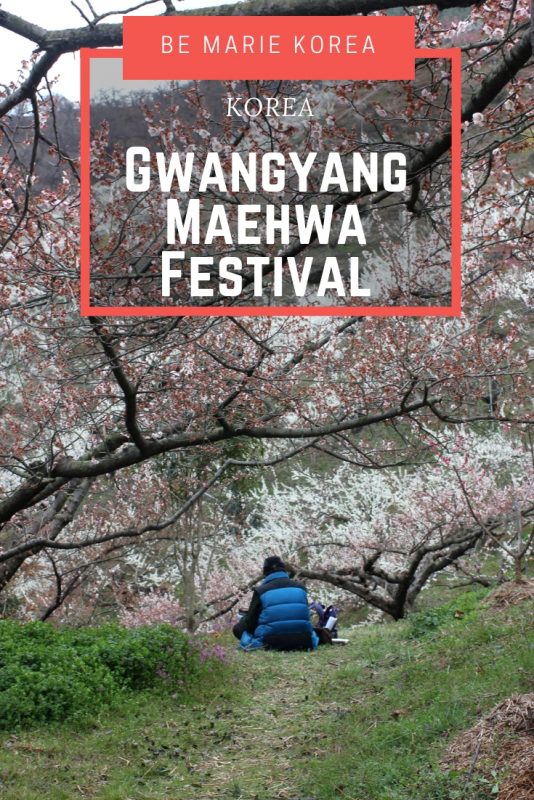


Frequently Asked Questions
What is the Gwangyang International Maehwa Festival?
The Gwangyang International Maehwa Festival is an annual spring festival held in Gwangyang, South Korea, celebrating the blooming of maehwa, or plum blossoms. It is one of the earliest spring festivals in the country, drawing visitors who come to enjoy the beautiful scenery, traditional performances, and local food offerings.
When does the Gwangyang International Maehwa Festival usually take place?
The festival typically takes place in early March when the maehwa trees are in full bloom. The exact dates can vary slightly each year depending on the weather and the timing of the blossoms, so it’s advisable to check in advance for the specific schedule.
What activities and attractions can visitors expect at the festival?
Visitors to the festival can enjoy various activities, including traditional Korean music and dance performances, guided walks through the plum orchards, and local crafts and food stalls. The scenic beauty of the blooming maehwa offers numerous photo opportunities, and cultural exhibits provide insights into the region’s heritage and agricultural practices.

